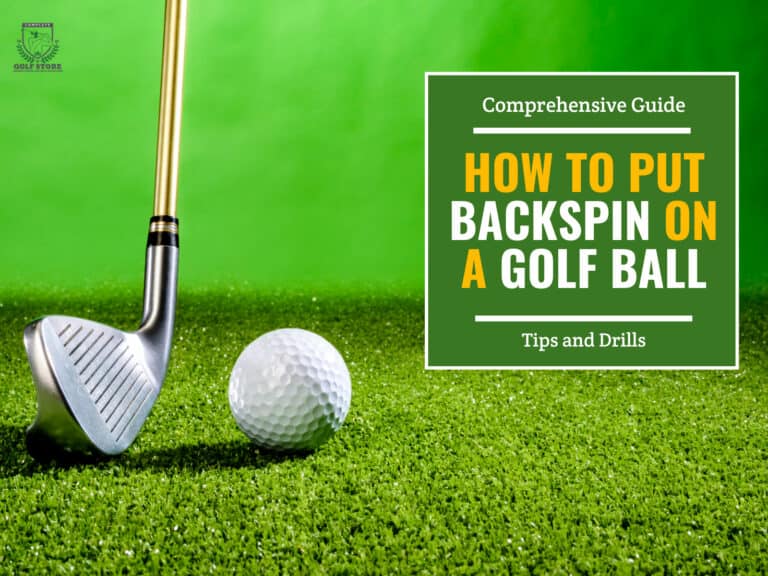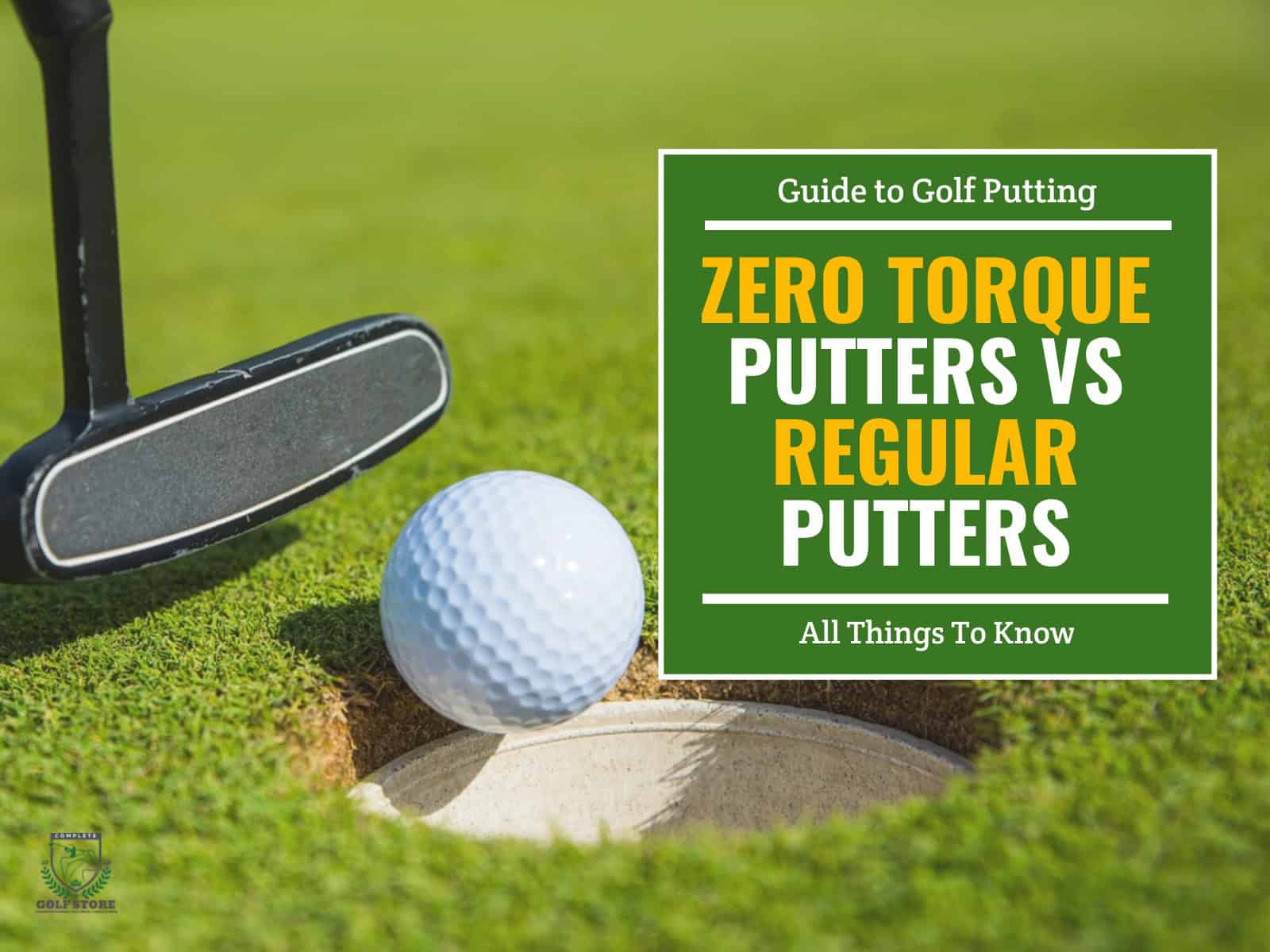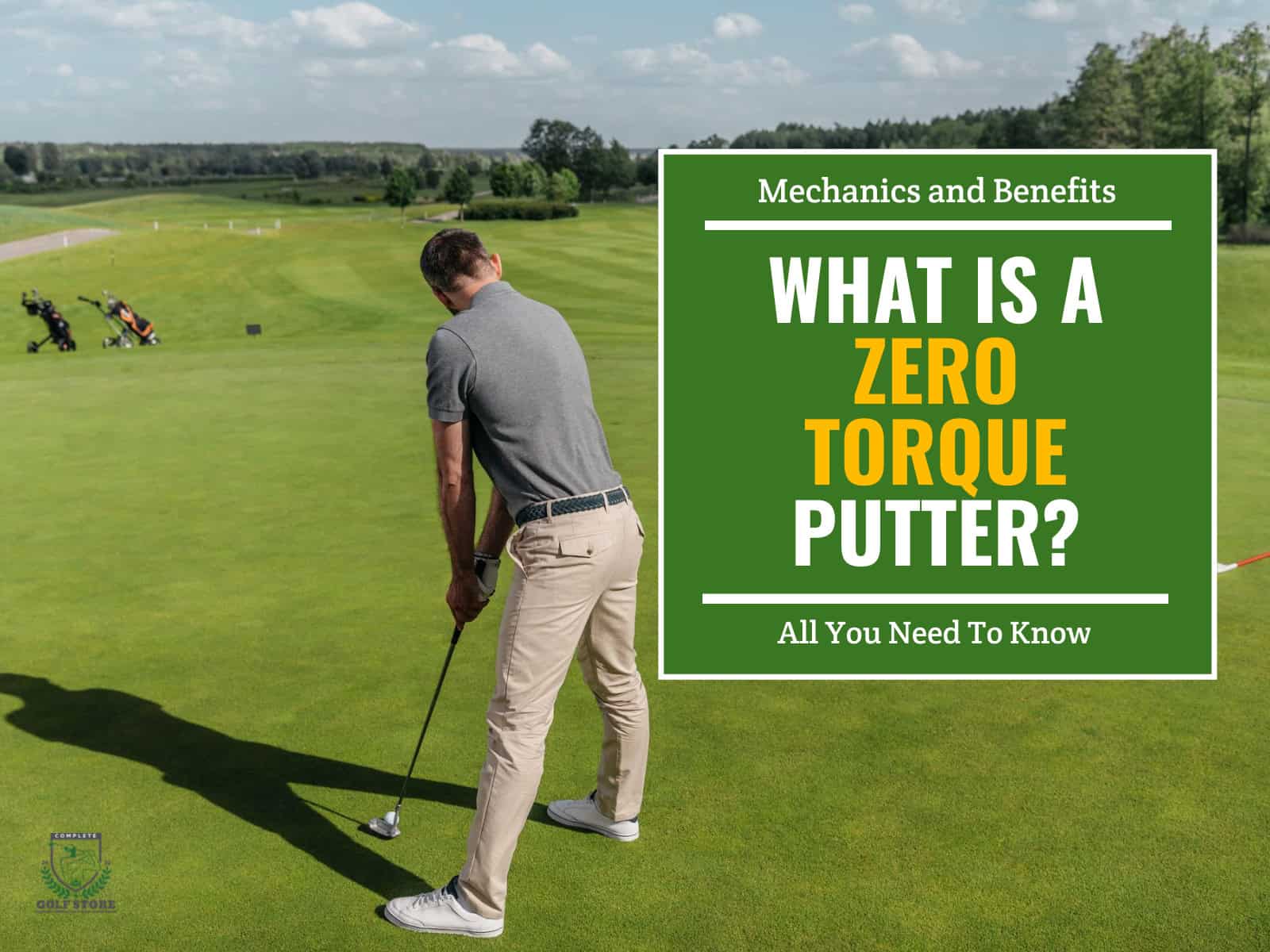Putting backspin is a great way to get more control and distance from your drives and shots. It’s a technique that separates the pros from the amateurs, but it doesn’t have to be intimidating.
With some practice and consistency, you can learn how to hit backspin in no time!
In this article, we’ll discuss what backspin is, why you need it, as well as tips and drills on putting it into action.
Let’s get started!
- 1) What is Backspin? & Why do you need Backspin?
- 2) How To Put Backspin on Your Golf Ball
- 3) Other Tips and Drills on Putting Backspin On Your Ball
- 4) Things To Avoid When Learning How To Hit Backspin in Golf
- 5) Is It Difficult To Generate Backspin On A Golf Ball?
- 6) Frequently Asked Questions
- 7) Conclusion
What is Backspin? & Why do you need Backspin?
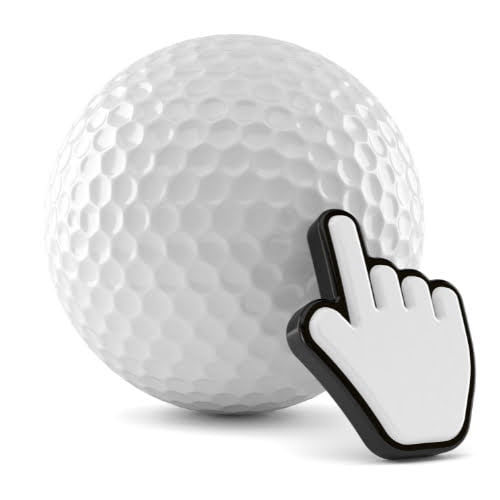
Backspin is the phenomenon that occurs when a golf ball spins backwards while in the air after being hit by a golf club. It is a crucial concept in golf, as it plays a significant role in determining the trajectory and distance of a golf ball.
With the right technique, you can achieve a shot that flies higher and farther than ever before – just by adding a little backspin!
When you hit a golf ball, there are tiny dimples all over its surface. With backspin, these dimples help create lift as the ball travels through the air, allowing you to hit it further. Additionally, spin also helps control where (and how far) the ball goes when it lands on the ground; this is particularly useful in short game.
How To Put Backspin on Your Golf Ball
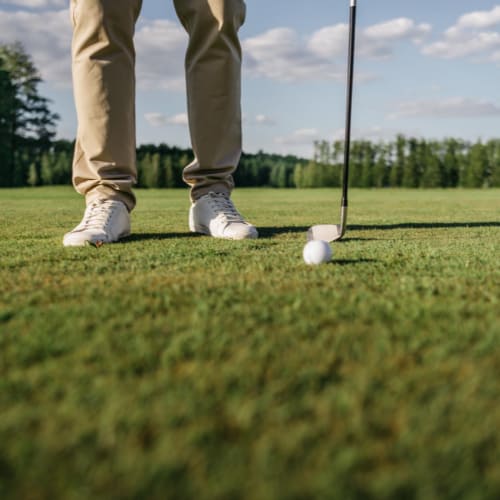
Mastering the art of putting backspin on the ball is essential. While professional golfers have it down to a science, amateur golfers tend to struggle with this technique.
From the right ball position to the perfect angle of attack, we’ll cover all the bases so you can start impressing your golf buddies with your backspin shots.
Swing Speed
Backspin is created when the ball rolls up the clubface and then slides up and off the clubface quickly, creating a lifting effect that reduces the ball’s initial launch angle and increases the ball’s spin rate. This creates a ball flight that allows the ball to stop or even spin back on the green.
The faster your swing speed, the more backspin you can produce on the ball. This is because a faster swing speed generates more clubhead speed, which in turn creates more ball speed and spin rate.
Additionally, a faster swing speed creates a steeper angle of attack, which means the club strikes the ball at a downward angle, producing more backspin.
So, how can you increase your swing speed to produce more backspin on the ball? Here are some tips:
1. Focus on your timing: proper timing ensures that your clubhead speed peaks at impact, maximizing your ball speed and spin rate.
2. Increase your flexibility and strength: Regular exercise and stretching can enhance your swing speed, making it easier to generate backspin.
3. Use lofted clubs: Using wedges and high-lofted irons helps to increase the spin rate of the ball because the clubface’s angle generates additional backspin.
4. Fresh grooves: Ensure that you’re using a club with clean grooves. Worn-out grooves can cause the ball to slide off the clubface, producing less backspin.
Loft

Lofting your club up gives you more distance and accuracy, as well as the added bonus of extra spin on your shots – without having to put in any extra effort.
In golf terms, loft is the angle between your club face and the center of your shaft. This angle can affect how much spin you’re able to generate with a particular shot.
A higher clubface angle means more backspin which can be very helpful when trying to stop the ball close to the pin or keep it from rolling away from the desired landing spot.
By controlling this angle, you’ll be able to obtain more consistent results with better ball control for each shot you hit.
Grass

The grass length where you hit your shot plays a crucial role in getting the desired backspin on your golf ball.
Generally, shorter grass, such as that found on fairways, is preferable when attempting to generate backspin. The reason is that shorter grass allows for more solid contact with the ball and increases the spin rate.
On the other hand, longer grass, such as that found in rough areas, can make it challenging to get the desired spin on the ball. This is because the grass can get between the clubface and the ball at impact, making it difficult to achieve a clean hit.
Additionally, the thicker turf in long grass also creates more friction, which can decrease the spin rate and ultimately defeat the purpose of attempting backspin.
To generate backspin, players should aim for cleaner hits, which can be achieved more easily with shorter grass found on fairways. The cleaner the hit, the more clubhead speed is transferred to the ball, which creates the necessary spin.
Face Angle
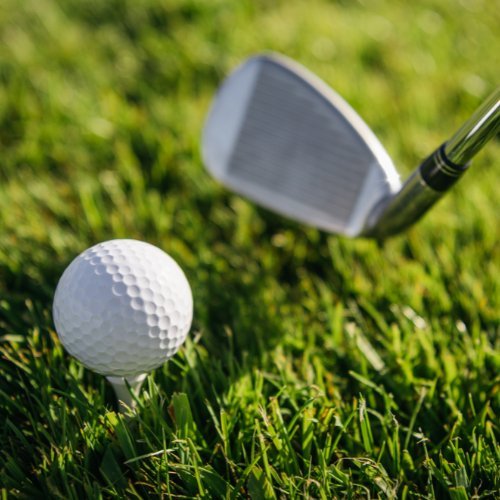
By ensuring your clubface is square at impact, you’ll ensure maximum spin for every shot. To achieve this, you need to understand the angle of attack and the relationship between the ball and your clubface.
The grooves on your clubface produce backspin when they contact the ball at a shallow angle. If the angle of attack is too steep or shallow, it will cause side spin instead of backspin.
An open face angle, where the clubface is angled away from the golfer, can produce a side spin on the golf ball, rather than the desired backspin. Similarly, a closed face angle, where the clubface is angled towards the golfer, can also produce side spin, leading to a hook or slice shot.
You must maintain a square face throughout your swing in order to have consistent backspin on every shot. This can be done by focusing on keeping your wrists flat through impact and not letting them roll over too early. Doing so will help keep your clubface square and create more spin with each shot.
Grooves

Grooves are designed into the clubface to create friction between the ball and the club, which helps generate backspin.
The more loft and clubhead speed you have, the easier it will be to put backspin on shots. Keeping your grooves clean and sharp can help get maximum spin from each shot as well.
However, it’s essential to note that golf rules have limitations on groove sizes and shapes to maintain fairness in the game. So, when purchasing clubs off the shelf, the grooves’ conformity should be considered to ensure optimal spin control.
Keeping your club grooves clean is also vital to maintaining optimal spin. Dirt, grass, and debris can fill in the grooves, reducing friction and causing the ball to slide off the clubface. Regular cleaning with a groove cleaner or a club brush can help optimize spin performance.
Angle of Attack
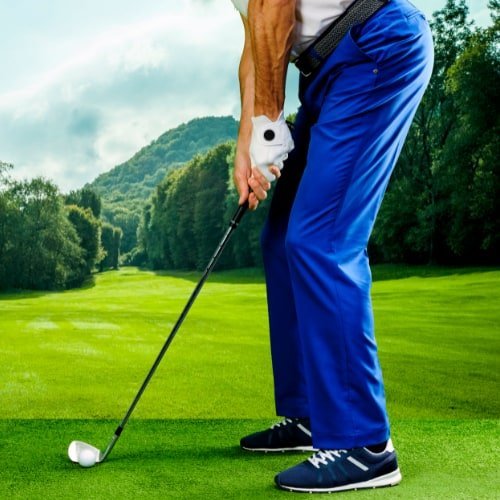
One of the primary ways to achieve backspin is by steepening the angle of attack. When the angle becomes steeper, the clubhead strikes the ball with a slightly downward angle, allowing the grooves on the clubface to grip the ball better and create more friction. This increased friction results in more backspin.
The ideal angle of attack will depend on your swing and personal preference, but should be adjusted in order to achieve clean contact with the ball and maximize spin potential.
Here are some tips to help improve your angle of attack and generate more backspin on your shots:
1. Reposition the ball back in your stance, closer to your trail foot: This position makes it easier for you to strike down on the ball, producing more spin.
2. Hinge your wrists early in the downswing: This movement creates consistent lag, allowing the clubhead to approach the ball from a steeper angle.
3. Use lofted clubs for wedge shots: Lofted clubs, such as the lob wedge, create more backspin due to their increased loft angle.
Other Tips and Drills on Putting Backspin On Your Ball
In addition to the commonly known techniques like using a steep angle of attack and fresh grooves, there are other tips that can help you put backspin on your ball.
Select The Appropriate Club For The Shot
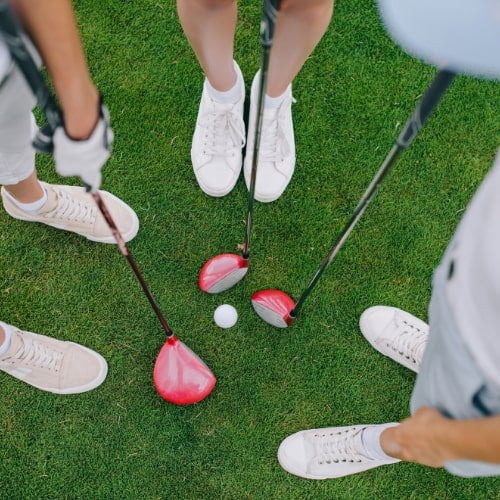
Generate the appropriate height and backspin, it’s important to use a lofted club. Wedge shots are particularly effective as they feature angled club heads which allow for optimal backspin generation. The lob wedge, specifically, is designed for maximum loft and spin, making it a popular choice for professional golfers.
For beginners or those wanting to improve their technique, it’s recommended to start with a sand wedge or a pitching wedge. These clubs feature angled club heads that promote backspin performance. However, when using these clubs, it’s important to pay attention to the ball position, momentum, and angle of attack to effectively generate backspin.
Understanding how far you can carry the ball with your pitching wedge is crucial for accurate approach shots. For more tips on mastering this skill, check out our guide on how to hit a pitching wedge here.
Before attempting a backspin shot, it’s important to check the club head for any dirt or damage that could potentially affect performance. A clean and undamaged club head will not only ensure optimal performance but also prolong the lifespan of the club.
Utilize A High-Quality And Appropriate Golf Ball
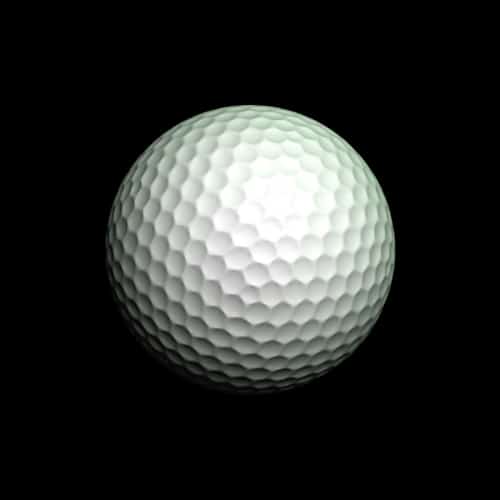
Beginner golfers should consider opting for a soft-centered ball. These types of balls are easier to compress and produce spin when compared to harder-centered balls.
Additionally, using a softer-centered ball can help a beginner gain a better understanding of their swing and ball flight. This aspect will enable them to observe the backspin generated and make necessary adjustments.
Proficient golfers can choose to use a harder-centered golf ball to generate backspin. Generally, more experienced players have a faster swing speed and a more consistent ball-striking technique. Therefore, using a harder-centered golf ball allows them to effectively compress the golf ball and produce the required backspin.
To achieve a higher rate of backspin on shots, it’s essential to use premium golf balls. Fresh grooves on wedges are crucial to obtain maximum spin, so a high-quality golf ball is necessary to complement it.
Golf balls with premium quality covers, though costlier, are known for their ability to grab the golf club’s grooves better, resulting in increased backspin.
Keep Your Grip Strong

Maintain a strong grip throughout your shot for the best spin, control, and accuracy – you can feel the difference with every strike.
A weak grip in golf swings will lead to an open clubface at contact which reduces spin on the range ball. If you want to increase backspin, you should focus on keeping your grip secure throughout their entire swing. This will ensure maximum contact between the golf club and ball, creating more spin.
Not only that, but a strong grip also helps with accuracy as it allows you to stay in control of your shots and hit them precisely where you intend.
Moreover, hitting the ball first and then the turf can also help you generate backspin on your shots. This means that you should avoid hitting the turf before hitting the ball to make solid contact and achieve better shots.
Things To Avoid When Learning How To Hit Backspin in Golf
Learning how to hit backspin in golf takes a lot of practice and patience to master, and it is important to avoid making some mistakes that will make your task unnecessarily harder:
- Do not attempt this shot if the wind is blowing towards you. Hitting backspin in a tailwind is a recipe for overshooting the green. Keep in mind that the wind affects the spin of the ball, and it is essential to choose the right conditions.
- Avoid playing a backspin shot if the green is sloping away from you. Hitting backspin on a downhill slope can result in an embarrassing bladed shot, or even worse, the ball will roll off the green.
- Do not hit a backspin shot with a worn-out golf ball or grooves on your clubhead. Consider replacing balls and clubs that have seen better days.
- Do not hit a backspin shot if you do not have the correct technique. Solid contact and a smooth swing strike the ball first and then the ground.
- Avoid playing backspin shots on long-range targets. Backspin is typically used for shorter range shots on approach or wedge shots. Using backspin shots on long-range targets can result in less control and not a decent golf shot.
Is It Difficult To Generate Backspin On A Golf Ball?
Learning to generate backspin on a golf ball can be quite challenging and requires consistent practice to execute effectively, but mastering it can make a world of difference in your game.
One of the most significant obstacles to putting backspin on a golf ball is the variable nature of conditions.
Different conditions affect the degree of backspin, such as the type of golf club used, the quality of the golf ball, the angle of attack, the clubhead speed, the ball position and the club’s loft.
Moreover, consistently applying suitable backspin can be challenging for beginner players who are still developing their swing and learning how to strike the ball cleanly.
Frequently Asked Questions
By now, you might have a few questions in mind related to the topic at hand. Let’s try to answer them all!
How Does Backspin Affect the Flight of A Golf Ball?
Backspin on a golf ball affects the flight of the ball in several ways. It causes the ball to lift off higher into the sky and travel farther than it would without backspin, due to increased air pressure beneath the ball.
Additionally, backspin can help keep your ball from running too far away from its intended target as it lands on the ground. This is because backspin causes drag, which slows down its forward motion and keeps it close to where you want it to land.
Finally, backspin also helps reduce side spin that can cause errant shots or slices.
Does Backspin Help with Accuracy?
Yes, backspin does help with accuracy when it comes to golf ball flight.
Backspin is created by a downward strike on the golf ball and causes it to spin as it travels through the air. This spin helps to reduce curvature mid-flight, allowing for more consistent and accurate shots.
What Is the Difference Between a Backspin Shot and A Topspin Shot?
Backspin and topspin shots are two of the most common types of shots in golf.
Backspin is when you hit the ball with a downward motion, causing it to spin back towards the direction of your swing after it has been hit.
Topspin, on the other hand, is when you hit the ball with an upward motion, causing it to spin forward away from your swing after being hit.
Both types of shots can help improve accuracy and distance depending on how they are used in different situations on the course.
What Club Should Be Used to Generate Backspin?
When it comes to generating backspin, the club you should use depends on your skill level.
Experienced players may prefer a wedge for its increased control and accuracy, while less experienced players may opt for an iron with more loft as it will produce a higher spin rate.
how Much Backspin Should Be Used to Achieve Desired Results?
The amount of backspin you choose will depend on what results you’re hoping to achieve. Generally speaking, a lower spin rate is better for long-distance shots, while higher spin rates are better for precision and control.
If you’re looking to make the ball really stick when it lands on the green, then aim for a spin rate of around 4000 rpm. This should help your ball stop quickly and stay close to where it landed.
On the other hand, if you’re just trying to get some extra distance off your drive, aim for a spin rate of about 3000 rpm. Keep in mind that these figures can vary based on your skill level and the equipment used.
Conclusion
Putting backspin on your golf ball isn’t as hard as it may seem. With the right technique and consistent practice, you can master this skill in no time!
All you have to do is focus on keeping your wrists firm while striking the ball with a downward angle of attack. Remember to also keep your clubface open, and ensure that you make contact with the bottom half of the ball.
For any questions or comments, feel free to contact us!


